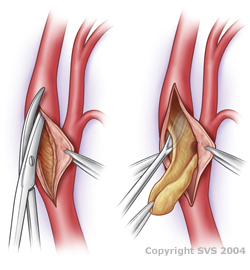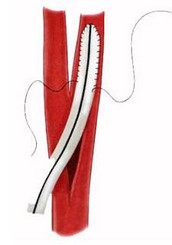In a small number of people a tight narrowing is discovered whilst under investigation for another problem. If this applies to you, you will still undergo the same preoperative tests, but you will be admitted to hospital electively for surgery.
The aim of carotid endarterectomy is to prevent you having a major stroke.
Before the Treatment
Before you have carotid surgery, there are a number of tests that need to be done to assess whether you are able to have the operation, and some immediately before the surgery (pre-operative tests).
Tests to see whether you are suitable for the operation include:
- Ultrasound scan MRA or a dye X-ray (digital subtraction angiogram) of the arteries
- Blood tests
- ECG (a heart tracing)
- Echocardiogram (an ultrasound test of the heart)
- Breathing test
- CT scan (special X-ray scan) of your brain.
You may also have a special MRI scan of your brain at the same time as the MRA.
These tests should have been done within a couple of days of your symptoms. If you are fit enough, you will then be offered an operation within two weeks of your symptoms.
The operation – the anaesthetic
Carotid endarterectomy can be performed under either regional (local) or general anaesthetic. Not all cases are suitable for regional anaesthetic and not all hospitals are able to offer this service. Your surgeon will advise you as to which method of anaesthetic you will be offered.

For a general anaesthetic, a tiny needle is placed in the back of your hand. The anaesthetic is injected through the needle and you will be asleep within a few seconds.
For local anaesthetic, the anaesthetist will make an injection into the skin of your neck to numb it. During the operation, if you become uncomfortable, the surgeon will inject more local anaesthetic. You will also be given some sedation, and as a result, you may not be very aware of the operation at all. Occasionally it may be necessary to convert to a short general anaesthetic during the operation.
A tube (catheter) may be inserted into your bladder to drain your urine.
A drip is placed into a vein in your arm (wrist usually) to give you some fluids during and following surgery. Sometimes, a second drip will be placed into an artery at wrist level to permit careful blood pressure monitoring during and just after the operation.
The operation
You will have a cut running vertically down from near the angle of your jaw / ear lobe towards your breastbone. The incision is usually 7-10cm in length.
Once the carotid artery is displayed, the branches of the artery are clamped to limit blood loss during the operation. A small incision is made along the artery and the plaque or narrowing is carefully removed.
When the inside of the artery has been cleared, it is closed with very fine stitches. A small patch will usually be stitched to the artery to prevent further narrowing. This patch is normally made of a material called Dacron, but sometimes a vein from your leg may be used or a piece of animal tissue (bovine).

The wound is usually closed with a stitch under the skin that dissolves.
To protect the brain from interruption to its blood supply while the artery is clamped, a shunt (narrow plastic tube) is sometimes used to maintain blood flow. The shunt lies in a loop outside the artery, passing into the artery above and below at each end of the incision in the artery.
To monitor the blood supply to your brain a special listening device may be placed onto your head. This allows the surgeon to hear and see how fast your blood is running, which will help them make decisions during the operation.
At the end of the operation your surgeon may look inside the artery with a special camera to check that the repair is satisfactory and that there is no blood clot.
Your surgeon may place a small plastic drain in your neck for a short period to look for bleeding and to reduce neck swelling after the operation.
Recovery and Aftercare
You will wake up immediately at the end of the operation (if it has been under general anaesthetic). Local anaesthetics are used to numb the skin in all cases so there should be little discomfort.
Following this sort of surgery you are unlikely to feel sick, and you should be able to eat and drink again within a few hours. Your mobility will return to normal more or less immediately.
There is often some swelling in the neck, but this settles within 7-10 days.
The incision on your neck will initially be very visible; however this will subside and become virtually invisible within 2-3 months.
A blood transfusion is rarely required.
Going home
Most people stay in hospital between 2 and 4 days after carotid endarterectomy.
If your stitches or clips are the type that need removing this is usually done whilst you are still in hospital. If not, it will be arranged for your GP’s practice or district nurse to remove them and check your wound.
Regular exercise such as a short walk combined with rest is recommended to provide a gradual return to normal activity.
Driving
You will be able to drive when you can perform an emergency stop safely and look over your shoulder easily. This will normally be 2-3 weeks after surgery, but if in doubt check with your doctor. You should inform your insurers that you have had this operation.
